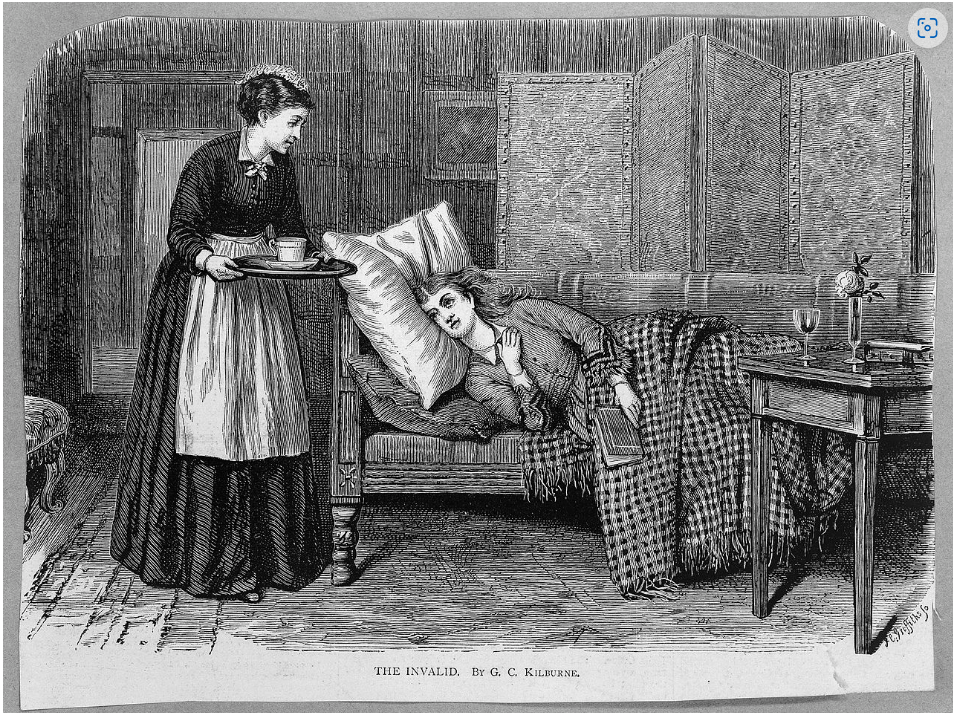
S. Weir Mitchell constructed a new technique to treat mental health, called the “rest cure,” in 1872. At first, it was used “as a treatment for injured veterans” who had fought in the Civil War (Stiles, “The Rest Cure, 1873-1924”). It continued to remain preeminent for the “next 50 years” as the use of this treatment continued to be used to cure other illnesses (Bassuk, 247). One of the most common usages for the rest cure was for women’s hysteria or mental illness. First coined in the 5th century, Hippocrates used the word ‘hysteria’ to mean “a wandering uterus” (Shetty et al., “Hysteria: A Historical Perspective”). Now, in Victorian England, the word is used to describe the symptoms that plagued the female mind and body.
Women could have been diagnosed with hysteria for a number of symptoms from PTSD and depression to a “fondness of writing” (Cohut, “The Controversy of ‘Female Hysteria’”). This “cure” became a popular solution to the problem of hysteria amongst Victorian doctors. Previously to this treatment, “leeching, cauterization, and “normal” ovariotomy-procedures” were used (Bassuk, 245). The “rest cure,” instead, has strict procedures involving rigid orders of rest, isolation, and giving up complete control to the doctor. Women were given a “heavy diet” and they “would have been forced feed” if they refused it (Stiles, “The Rest Cure, 1873-1924”). The patient was not allowed to leave her bed during this time and only received exercise through “massage and electric simulation” (Stiles, “The Rest Cure, 1873-1924). A newspaper article from Lloyd’s Illustrated Newspaper included instructions of how to preserve a women’s health. One of the steps includes “Exciting books and trashy, sentimental novels and tales must be debarred” (Wilson, Lloyd’s Newspaper). This cure usually lasted a few weeks, in which their social circle was extremely limited. In their state, these women were seen as “vampires sucking the blood of the healthy people of a household” and were prescribed to stop “sharing their feelings with others” (Bassuk, 249).
In response to the rest cure, many feminist writers took a stand against, like Charlotte Perkins Gilman in her “The Yellow Wallpaper.” Charlotte Perkins Gilman portrayed the harmful impact of this “treatment” in her short story where a women suffered through this cure. In the end, though, the protagonists suffered a mental breakdown because of her treatment. While this may be just a fictional story, it shows the real lives of many women. Gilman, being one of the women, felt herself “teetering on the edge of a nervous breakdown” while on this treatment (Bassuk, 252). This historical event, like that of the Seattle lawsuit on social media, explores the theme of mental health and the affect media add on it. Seattle is suing social media because it had led to a mental health pandemic, one that they cannot keep up with. In Victorian England, the “rest cure” prohibited “sentimental novels” and “exciting books” because they believed it led to mental exhaustion and an increase of nerves (Wilson, Lloyd’s Newspaper).
Connection: Women were not the only who did not receive proper help with their mental health. You can read more about the men who suffered from PTSD after being pressured by society to enlist in a war here: https://editions.covecollective.org/chronologies/wilfred-owen-and-evolution-dulce-et-decorum-est.
Picture:
Price, David. “Period Drama.” National Museum of Civil War Medicine, 19 Jan. 2021, www.civilwarmed.org/menstruating/.
Primary:
"HEALTH & HOW TO PRESERVE IT." Lloyd's Illustrated Newspaper, 17 Dec. 1893. British Library Newspapers, link-gale-com.proxy.ulib.uits.iu.edu/apps/doc/BC3206286645/BNCN?u=iulib_iupui&sid=bookmark-BNCN&xid=53055c57. Accessed 27 Apr. 2024.
Secondary:
Bassuk, Ellen L. “The Rest Cure: Repetition or Resolution of Victorian Women’s Conflicts?” Poetics Today, vol. 6, no. 1/2, 1985, pp. 245–57. JSTOR, https://doi.org/10.2307/1772132.
Other Works Cited:
Shetty, Siddharth A.; Chandini, S.; Fernandes, Sharol Lionel; Safeekh, A. T.. Hysteria: A Historical Perspective. Archives of Medicine and Health Sciences 8(2):p 312-315, Jul–Dec 2020. | DOI: 10.4103/amhs.amhs_220_20
“Anne Stiles, ‘The Rest Cure, 1873-1925.’” BRANCH, branchcollective.org/?ps_articles=anne-stiles-the-rest-cure-1873-1925#:~:text=While%20the%20rest%20cure%20is%20today%20associated%20with,a%20treatment%20for%20nervous%20invalids%20of%20both%20sexes
Cohut, Maria. “Female Hysteria: The History of a Controversial ‘Condition.’” Medical News Today, MediLexicon International, 13 Oct. 2020, www.medicalnewstoday.com/articles/the-controversy-of-female-hysteria.
